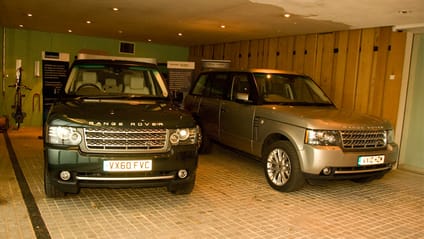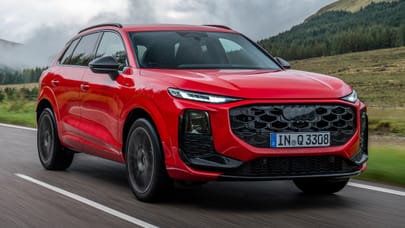
Is in-car music about to take the next leap forward?
An 1980s recording legend is claiming just that… Top Gear reports


It’s an undeniable fact we spend a scary chunk of our music-listening time in the car. But ask any music geek: cars are acoustic disaster areas. They combine reflective surfaces like glass with big, squishy, sound absorbing seats all arranged to ensure that, at best, only one person gets to sit in the acoustic sweet spot and that’s usually the driver.
Words: Charles Armstrong-Wilson
Advertisement - Page continues below
Last week Top Gear spent some time with 'legendary' record producer Steve Levine who’s taken it upon himself to turn all this on its head. And Levine has earned the right to pronounce on all things tuneful: he made his name engineering the Clash in their early days (hero) and produced all Culture Club’s albums (well, they sold a lot).

Levine has long maintained that music producers have always had to engineer around familiar problems to make their music sound good in cars and on the radio. Engaging geek mode, he pointed out: ‘In a car the surfaces are highly reflective, a lot of it is glass and it’s in a square box.
The classic problem you have is that there are things called standing waves. As sound hits one side it bounces backwards and forwards, the same as if you’re standing in the middle of a canyon and you hear your voice echo. It’s the same principle but very, very short. That destroys the frequencies in the mix.’
Advertisement - Page continues below
But he’s convinced that recent technology can finally allow cars to match the wire-strewn “listening room” of the most cable-addicted audiophile. Crucially, systems like Surround Sound 5.1 and Harman Kardon’s Logic7 now allow the music in the car to be micro-managed, and Mr Levine is a leading advocate of creating mixes engineered specifically for cars. ‘Oddly enough one of the best listening experiences is going to be in your car because you’re in a known environment.

Your house has moveable furniture and things that change, whereas once it’s in your car it’s pretty fixed so you can spoil yourself and get it how you want it. Yes, there are problems with glass panels etc, but that’s all that is taken into consideration.
Yes, there are X number of windows, but they are going to stay the same. Once you know what’s there, you can adjust everything perfectly to make sure that it works. Your home is a more variable environment, particularly if the speakers are not built. You only have to Hoover and move a speaker and suddenly you’ve messed everything up.’

Given the sheer number of hours the Top Gear team spend in a driving seat bellowing along to blessedly-private compilations, we headed to British Grove Studios in Chiswick to see what he meant. Levine had lined up Ivor Novello-nominated band Patch William to record a demo.
With the track done, he mixed it in front of us to suit the strengths of Surround Sound, then played it back in the recording studio control room. The shirt-billowing performance was everything he promised.

Then, with it burned to DVD we were treated to a rendition in a Range Rover Autobiography equipped with a leading surround sound system: Harman Kardon’s Logic7 HD system (this one’s exclusive to the Rangie model, and highly recommended for audiophiles/Mojo readers). And did it compare well? Not half.
While you couldn’t say it was indistinguishable, it was pretty damned close, and blew into the weeds all preconceptions about the limitations of the car as a listening environment. Switching in and out of Logic7 was the difference between hearing it come from an identifiable source to being immersed in the sound. Live concert levels of good.
Advertisement - Page continues below
‘We can choose what we want to go out the back,’ says Steve. ‘At first we only had the room mikes coming out there. It sounded great in the front of the car but in the back it sounded like you were in the toilet outside. Then we thought let’s experiment; where can we put things. And it’s only when you start playing with the stereo you start thinking, wow that’s really interesting with that over there because it focuses the listener on certain things.’

Conclusion – a success. Now you just need to get the right surround-sound kit, an 80s record producer, and your own Ivor-Novello nominated band. But it’s a start, and shows what could be possible in the very near future if the likes of Levine get their way.
Advertisement - Page continues belowSTEVE LEVINE – AN INTERVIEW

On... The Clash
We were all the same age, 18 to 19 and we had quite a lot in common. We’d listened to the same records growing up as teenagers. They were inexperienced, as we were and I think that was what captured the sound. Over one weekend we recorded the first batch of songs, which initially CBS intended to be demos but those became the first block of recordings, which included White Riot.On... digital recording

By the early eighties it was fairly obvious that digital recording was going to be the new benchmark. Because of the success I’d had I was able to invest in digital technology very, very early on, in fact I was one of the first producers to have a digital tape machine. It coincided with the third Culture Club album and my commission for working with the Beach Boys. The Beach Boys, throughout their entire career, have always been known for pushing the boundaries of recording. Brian Wilson used eight-track recording very, very early on when it was still in its infancy.

So, in the conversations, before we even started recording, they were very keen on using the very latest technology that was available. I showed them some very early examples of how great their vocals would sound if they were digitally recorded rather than analogue and this made a significant difference to the perception of the vocals.
They leapt on it and we went vocal mad, recorded track after track after track of vocals and we created quite a rich vocal sound using the digital technology.
On... current recording techniques

One of the things that we’re always fighting against is the thing with levels. A lot of engineers are being forced by labels to make their records incredibly loud but the downside of that is when they’re encoded for MP3, they don’t sound particularly good. Consumers are listening at unbelievably high volume to get the same feeling, because I think there is a psychoacoustic feeling from enjoying music and this is what’s causing hearing damage.
People are listening so loud because they are not getting the feeling they once got when they listened to their hi-fis or their records where they had dynamic. Here’s a chance now with 5.1 to put back that range and allow subtleties.
On his choice of driving music...

Depending on the mood, I’m quite a connoisseur of this. During the day, it can be a whole range of genres. A lot of Americana sounds good, from something as obvious as the Eagles to current Americana like Best Coast. Dance: You’re the One for Me by D Train, that sounds great in a car.
Late at night I’m really specific. Charles Mingus, Goodbye Pork Pie Hat. Bob James, who did the theme from Taxi. Dolphin Dance, the Herbie Hancock classic and all that mid-’70s soul jazz. And much of the core output of 6 Music sounds great in a car. Delphic sounds fantastic, as does XX who I got into first time round through my daughters. We have an iPod sharing scheme. But I have incredibly eclectic taste!
Trending this week
- Car Review
BMW 1 Series







